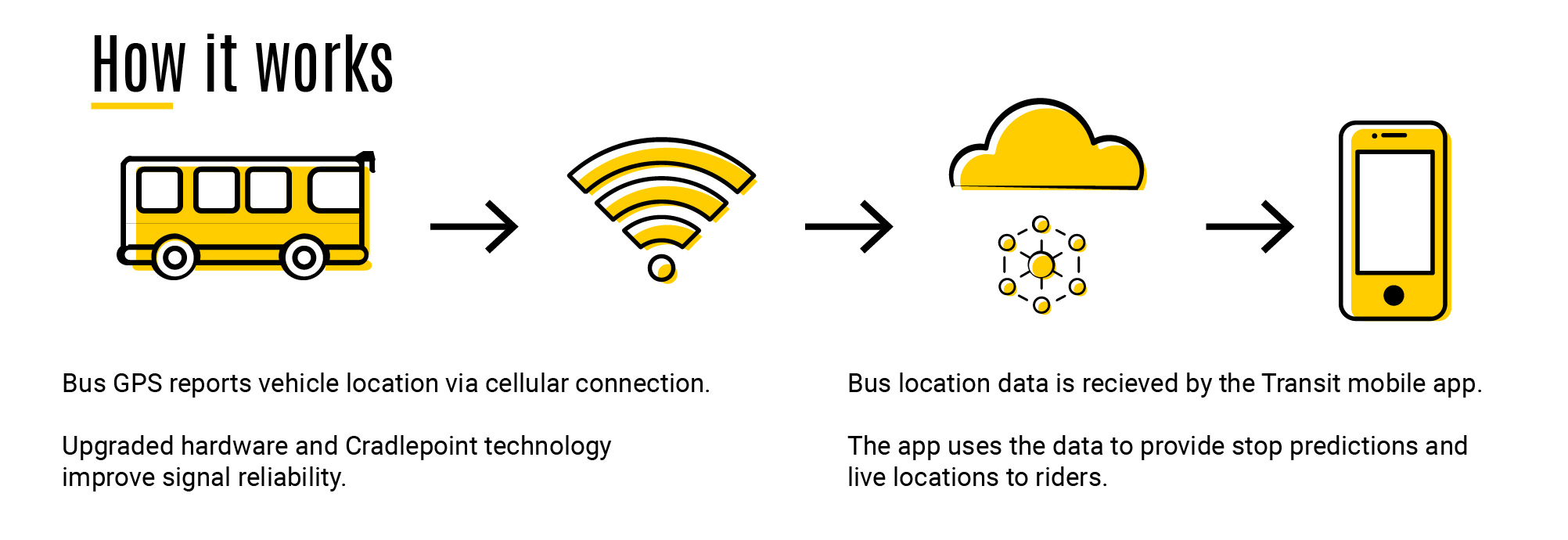CAMBUS riders are now seeing more accurate bus locations in the Transit mobile app, thanks to upgraded GPS equipment and cellular technology. The upgrades were installed in all buses in mid-December and offer improvements for both riders and Cambus operations.
“The Transit app is one of the most important resources we offer to riders,” says Cambus operations manager Mia Brunelli, “so we opted to completely replace all the components of the system.”
All things GPS
Live GPS data from buses allows the Transit mobile app to predict departures and show live bus locations. The new equipment improves communication with the app so bus locations can update more consistently. Riders should see fewer instances of live locations freezing or inaccurate stop predictions.
Cambus will also receive better data for monitoring service due to these upgrades. “GPS data is used by our operations team to monitor and resolve service issues. There are daily and long-term benefits for service from this upgrade,” added Brunelli.

About Cradlepoint
Cradlepoint hardware improves and stabilizes network connections for onboard equipment that relies on cellular data. This enables:
- more reliable GPS signals to send to the Transit mobile app
- the use of Automatic Passenger Counters
- exploring other technology that requires a strong network connection
The new hardware replaces equipment installed in 2017. Each bus received new GPS equipment, mobile data terminals, and automated voice annunciation system. A Cradlepoint system was also installed on each bus. Cradlepoint hardware serves as a signal booster and enables Cambus to explore additional types of technology in the future.
Automatic Passenger Counters
In addition to the new GPS systems, Automatic Passenger Counters (APCs) were installed on two buses as part of a pilot program. APCs use sensors in the front and back doors to count riders boarding and exiting the bus. The data is then sent to Cambus administration in reports that show ridership trends and help plan services.
Cambus currently collects boarding data using manual entry into the mobile data terminal tablets on each bus. Each time a rider boards a Cambus, the driver records that boarding in the tablet. This method does not collect the number of riders exiting each stop.
With APCs, Cambus will receive detailed data on riders boarding and exiting to inform service planning decisions. APCs could also provide more accurate ridership information by reducing human error in the data collection.
“Our top priorities for drivers are to safely operate the vehicles and provide good customer service. Not only can APCs provide us more information for service decisions, it also allows the driver to focus more on their primary task of safe service delivery” says Brunelli.
The APCs will be tested for accuracy over the coming months. If the pilot is successful, APCs may be installed across the fleet later this year.
All about APCs
Because the APCs record both boarding and exiting data, the system also understands how full a bus is. This data can be used to:
-
Show riders how full a bus is before it arrives in the Transit app
-
Help predict rider patterns for scheduling
-
Help plan service changes
Did you know?
Cambus reports monthly and yearly service metrics to the National Transit Database. Service metrics include number of boardings, miles traveled, and hours of service provided. These stats help determine how much federal and state funding Cambus receives.
